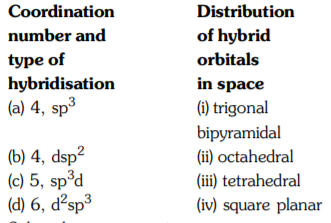Hybridisation calculation | Comparison of hybrid orbitals
Step by step video solution for Hybridisation calculation | Comparison of hybrid orbitals by Chemistry experts to help you in doubts & scoring excellent marks in Class 11 exams.
Updated on:21/07/2023Similar Questions
Lattice energy Problems | Lewis dot structures and formal charge | Dipole moment and Application of dipole moment Questions | Calculation of Hybridisation | Comparison of hybrid orbitals
View SolutionLattice energy Problems | Lewis dot structures and formal charge | Dipole moment and Application of dipole moment Questions | Calculation of Hybridisation | Comparison of hybrid orbitals
View Solution
Knowledge Check
sp3d2 hybrid orbitals are
AlinearBpentagonal bipyramidalCtrigonal bipyramidalDoctahedralMatch the coordination number and type of hybridisation with distribution of hybrid orbitals in space based on valence bond theory.
 Aa-ii,b-iii,c-iv,d-iBa-iii,b-iv,c-i,d-iiCa-iv,b-i,c-ii,d-iiiDa-iii,b-i,c-iv,d-ii
Aa-ii,b-iii,c-iv,d-iBa-iii,b-iv,c-i,d-iiCa-iv,b-i,c-ii,d-iiiDa-iii,b-i,c-iv,d-iiAn sp3 hybrid orbital contains
A1/4 (s-character)B1/2 (s-character)C2/3 (s-character)D3/2 (s-character).
Hybridisation And Properties of Hybrid Orbitals
View SolutionAssertion: Hybridisation is involved in the production of hybrid vigour or heterosis.
Reason: Hybrid is obtained by crossing the selected inbreed lines.
View SolutionAn sp3 hybrid orbital possesses
View SolutionHybridization is a concept of mixing or merging of orbitals of same atom with slight differences in energies to redistribute their energies and give new orbitals of equivalent energy called 'Hybrid Orbitals'. Hybridisation is a hypothetical concept and never actually exists.
One should not be confused by a common misconception that hybridization is responsible for particular geometry. Geometry of a molecule is decided by energy factor not by hybridization. It is the orbital (which may be half filled, completely filled or empty) that undergoes hybridization and not the electron. The bond angles in hybridised orbitals are influenced by presence of lone pair, presence of multiple bonds, presence of one electron and electronegativity of atom.
An increase in s-character of hybridised orbitals results in decrease in size of orbitals. This results in decrease in bond length and increase in energy.
Which of the following statement is not true?
View SolutionHybridization is a concept of mixing or merging of orbitals of same atom with slight differences in energies to redistribute their energies and give new orbitals of equivalent energy called 'Hybrid Orbitals'. Hybridisation is a hypothetical concept and never actually exists.
One should not be confused by a common misconception that hybridization is responsible for particular geometry. Geometry of a molecule is decided by energy factor not by hybridization. It is the orbital (which may be half filled, completely filled or empty) that undergoes hybridization and not the electron. The bond angles in hybridised orbitals are influenced by presence of lone pair, presence of multiple bonds, presence of one electron and electronegativity of atom.
An increase in s-character of hybridised orbitals results in decrease in size of orbitals. This results in decrease in bond length and increase in energy.
Which of the following statements is true?
View Solution
